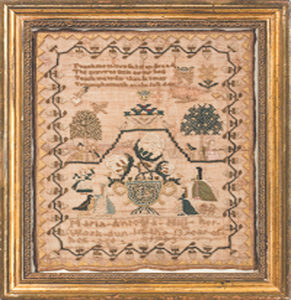 The Daughters of the American Revolution have an opportunity to secure a rare piece of American history. The organization is hoping that the Giving Tuesday campaign will help them in their effort to purchase the quilt for their museum.
The Daughters of the American Revolution have an opportunity to secure a rare piece of American history. The organization is hoping that the Giving Tuesday campaign will help them in their effort to purchase the quilt for their museum. This rare 18th-century American Sampler was made by a little girl born in the midst of America’s fight for Independence. One of eight children, Maria Antonia Hill was born in 1779 in Charleston, N.C. Maria moved with her family to St. Augustine, Fla., in 1785 or 1786, joining the very small community of wealthy Americans, mostly from the South and of British Isles ancestry.
It is in St. Augustine, the oldest continually settled European community in North America, that Maria worked on her sampler, stitch by stitch. This beautiful pictorial sampler is signed, “Maria Antonia Hill her work dun (sic) in the 13th year of her age 1793.”
Young Maria could not have imagined that some 200 years in the future, her artwork would still be telling her story—that her needlework would survive into the 21st century to inspire the people of this country. Giving Tuesday may give the organization the opportunity to see that Maria’s sampler has a safe, permanent home and that her story continues to be shared with generations to come.
A goal of $35,000 has been made, with $18,000 of that to secure this unique needlework piece. All remaining donations will enable them to bring other significantly historic pieces to the fully accredited Museum in the future. This not only gives the Museum curators the freedom and resources to find specific pieces that help tell the American story, but also enables them to make future purchases without having to rely on separate fundraising events.
This is, by far, the older of only two samplers from Florida from before 1850 known to have survived the humid climate that destroyed many antique textiles. Although this pictorial American sampler shares overall characteristics with other American samplers of the late 18th century, the images depicted in Maria’s sampler do not resemble samplers made elsewhere in Charleston, Philadelphia or New York City. This piece is unique in both origin and design.















Follow Us